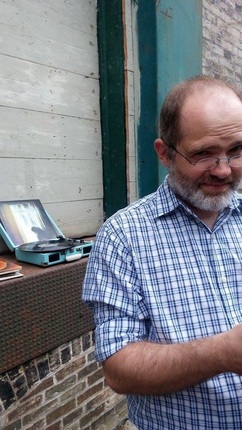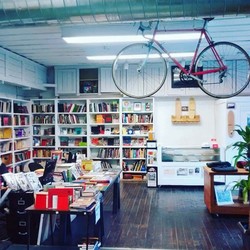
His work has also appeared in Geist, Rue Morgue, CNQ, Open Letter, Broken Pencil, Kotaku, and Quill & Quire.
Today in London, Ontario, Mr. Dickson co-owns & -operates an antiquarian bookstore, Brown & Dickson, with his partner, Vanessa Brown.
Images of Canadian postcards on which the narrative is handprinted convey the text of The Hunt (BookThug, 2006) with black-and-white photographs apposing. The lines, therefore, enjamb at point of restriction, rather than what we might otherwise think of as intention. Additionally, some postcards bear crossed-out, ostensibly miswritten words.
Offer a thought or two, if you will, about the book’s form. Why postcards? Why were ‘mistakes’ printed? Why appose the text with photographs? How do these choices reflect your area of expertise, Canadian literature?
The postcards were a happy accident. The story was displayed at a London Ontario art exhibition (curated by Kirtley Jarvis) and I needed a way to exhibit the story sections in a gallery. I was working at a used bookshop at the time and Kirtley came in to talk about the show. We were brainstorming ways to mount the sections. I was at the front counter which had the postcard section behind it at the time and we were both like, "Of course!" and went from there.
I purchased 100 postcards and went to work. They were all from Canada, of course. And I planned right from the beginning to keep my handwritten mistakes. I loathe perfection and that was part of it. But also I think it just makes things a little more creepy, off-centre. Lovely accidents happened again when Jay (at Bookthug) started to lay out the book. At one point we even considered a perforated book where you could remove the postcards and arrange them yourself.
The postcards lock the story in Time. But because they were historically also meant to be sent in the mail (and some do have postmarks) they also become ephemeral. This conflict was very important to me. I was deep into London Regionalism at the time and wanted a way to exhibit both timelessness and locality. The postcards added that final layer of substance. ....................................................

One of the reasons why this book feels distinctly Canadian is that its words seem to imply our early landscape demanded too much hard work to elicit tawdrily floral language. The location of the story, in other words, seems to want the verb and the noun rather than the adjective. For example:
The son rebuilds the cart
in the fort. He builds:
Thicker walls. Windows
and doors. A stove. Shelves
(stained red). An axle
for the front.
Gertrude Stein stressed the importance of verb and noun to define an American idiom. Was stalwart language in this dialect-confirming sense intentional, or were the choices regarding diction more intuitively made to serve the story?
I really appreciate that observation. One thing I like a lot is a character who has come to the edge of their ability to explain things. This is a classic ghost story trope, but it is one that I think works well with poetry. The characters in The Hunt have never experienced Canada before. And the civilization there has not established itself yet. So you see their efforts on the page to put into words their sorrow and ambition. I love that.
I also really wanted to avoid and comment on the earlier Canadian need to import British styles, and perhaps this is the noun problem you sense. I wanted to find this sort of book in our literary history. I really really wanted to read a book like this -- some weird, folksy, pioneering work that made sense outside of the normal Victorian language. I searched the London Public Library (which was on Queen Street at the time) for it and couldn't find it. The Hunt answers that need in a way.
Talking about his time in the mountains as an adolescent, Gary Snyder said, “It gives you another perspective on space and on time. Seeing all those vast forests up there gave me a sense of what North America was like, what it had been like.”
I wonder whether Snyder’s sense of time might speak to the fact that the book isn’t paginated. Was this decision made to avoid a sense of chronolinearity, or to render time’s suspension in a way akin to your characters’ experience of the Canadian environs?
Yes, completely. These objects and this story needed to float in space, float in the book. Jay and I spent a lot of time discussing exactly how to achieve that. Certainly not having page numbers was a decision of ours. I think he did an extraordinary job laying out and designing the book.
Li-Young Lee said he thinks of language as “a tool we use to inflect silence so we can hear it better.”
In this vein, you describe intervening, unwritten narrative with the wonderfully simple phrase, “And later:” For our reader, here are two examples:
“Where is our mother?”
“She’s in Driersville,
the Sunken Village.”
And later:
“Where is Driersville?”
“I don’t know. Look at
the map.”
And later:
“Its not on there.”
“We’ll put it there, when
we find it.”
(&)
“We’re going to Kanata, to
Driersville, where the
wolves live.”
And later:
“Driersville. You never
believe a word that I say.”
I wonder if you’d offer a few words about this evocative technique, and why its use felt appropriate to this story –– might it have anything to do with the wasteless Canadian language about which I asked you earlier? Could the importance of silence in Jazz or architectural space, for example, have something to do with this choice?
I think the Canadian connection is appropriate. I wanted the sense of something being built as you read. You are building it as a reader as the characters build it. The Hunt is I think in part about these characters searching for a home. The kids in the book have been upended, as has their father, and we watch them both fall apart as well as construct their new environment on the fly (as kids will do). And yes the space has so much to do with it. Architectural space too. There are a lot of empty rooms and vacated towns in the story. Also, considering the size of our country the characters would have spent a great deal of time in limbo, transit. And I wanted to convey that expanse in the microform of poems. Also by then I think the characters are hardly talking to each other, so the sense that a great deal of time passes between conversation works to build that sense of loneliness and solitude.
As for the simple phrases I felt they added a sad simplicity to things. All of this horrible stuff is happening and it is being framed by the simplest storytelling tropes. There is something very sad about that to me.
As they pull away and
continue west the carriage
develops a unique, interior
sound. It pieces together a
hum, a berth, its own space.”
If we may use these lines as a doorway, I wonder if you’d say a few explanatory words about Brown & Dickson –– as a business, as a venue, and about some of the upcoming events to be held there.
I like that you highlighted this part of the book. It is one of my favourites. I remember writing that and feeling very liberated afterward. Here was the whole book in a single passage. Once I nailed that a lot of the other parts were able to come together. I loved the idea of this carriage ambiently coming to life in a way, becoming its own character in the book. I had diagrams of all the little secret compartments and stuff. I can still crawl into that space today. I love it.
As for the shop I can't see a connection, only that bookselling is a creative act. We are always having to reinvent how we do things. I've never used my brain so much. It is very satisfying.
Brown & Dickson is located at 211 King Street in London, Ontario. There, a Bad Art night will be hosted on the 25th of June; and here's a Facebook link to that event. Want to take part? Email info@londonfuse.ca or books@brownanddickson.com
Here's a link to an interview with Jason regarding Glenn Piano by Gladys Priddis
Here's a link to an interview, conducted by AbeBooks, with Vanessa and Jason, regarding Brown & Dickson.
And here's a link to BookThug's website. Through it, you can purchase The Hunt and/or Glenn Piano by Gladys Priddis.
 RSS Feed
RSS Feed